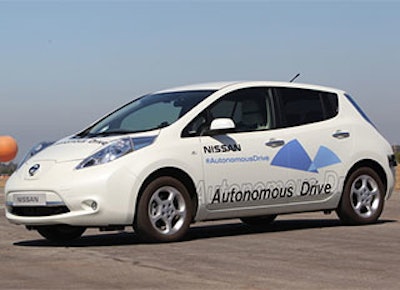
If you had a chance to “drive” to work tomorrow without having to touch the steering wheel or press down a pedal, would you do it? Technology is getting closer and closer to making this a possibility. Think of the amount of time commuters everywhere could gain back – without having to actually think about driving, commuters can now safely take a phone call, catch up on the news, or maybe even nap (if you’re the type to put complete trust into driverless technology).
Nissan has recently pledged to introduce driverless cars to the market by 2020, which is conveniently timed with recent data that Americans simply love driving less. With the American love affair with the automobile drawing to an end, maybe giving “drivers” the option of not having to actually drive is the next natural step. Data from the Federal Highway Administration reports that annual miles driven per person is down over 10 percent in some cases (like in North Dakota), while the dip is a bit less pronounced in other states (such as in Texas and Wisconsin). Being a Wisconsinite myself, I can unquestionably say that I’m driving now more than ever.
But despite states like Wisconsin, the data shows a clear driving decline, despite the recovering economy and a growing population. Fewer teens are getting drivers licenses, but even for those that have that precious piece of ID, the automobile is simply not the symbol it once was – it no longer means freedom. In many large cities, public transportation can provide just as much freedom as a car, if not more (shelling out $20 for one day of parking made me wish I had taken the Metro in D.C.). And further displacing the car are online stores (Amazon.com has infinitely lessened the pain of my holiday shopping), retired Baby Boomers who are turning in their licenses, costly gas, and cars that are – simply put – just too expensive to own (I try not to think about how much I spend on gas, registration, insurance, and regular maintenance every year). “It’s all economics,” said Sean McAlinden, economist with the Center for Automotive Research in a recent AP article.
The economics part of the story doesn’t bode well for the first driverless car for sale, which could top $150,000 per car by one estimate, with $70,000 of that spent on just the laser rangefinder. A new gadget is always more expensive than future models, of course, but it will likely take some time for the price of the driverless car to appeal to the masses. Nissan has promised that its autonomous car will be achieved by 2020 “at realistic prices for consumers,” but only time will tell.
Even $150,000 for a brand-new, driverless car seems like a deal when you consider the price of driver inattention and human error: Six million crashes, $160 billion, and the top reason of death for four- to 34-year olds. 93 percent of accidents in the U.S. are caused by human error, and most often ‘simple’ inattention. We’ve all seen someone texting while behind the wheel or applying makeup while behind the wheel or maybe even turning around to wrangle a small child or unruly dog – while the car is moving. Only 12 states have banned hand-held cell phones while driving (Wisconsin is not one of them, though texting while driving is illegal here).
Speaking of the legalities of getting behind the wheel – what are the chances of driverless cars being legally allowed on the roads by 2020? While self-driving cars have been given the OK for testing, the U.S. Department of Transportation hasn’t yet placed its faith in autonomous transportation. As of now, driverless cars are not completely legal – but they’re also not really illegal.
States can set their own driving laws (for example, the range of cell phone use laws behind the wheel). Autonomous cars are legal in California, Nevada, and Florida. Despite the laws not specifically requiring a driver behind the wheel, California has officially declared driverless cars street-legal by giving them the OK as long as there’s a licensed human in the driver’s seat to take over if needed. Nevada law now gives the Nevada Department of Transportation the authority to set safety and performance standards when it comes to driverless technology (this includes designating where driverless cars can be driven). Florida law allows self-driving car testing, in hopes that preparing for unmanned cars will create jobs for Floridians. While the majority of states don’t have current laws on the books expressly prohibiting driverless cars, the liabilities should a crash occur are probably sufficient to deter driverless testing on Manhattan streets, for example. Who gets the ticket – the driver, the autonomous car manufacturer, the computer programmer? This paper from a Stanford Law Resident Fellow discusses the legalities of driverless cars in more detail, here.
In an effort to provide some guidance to states permitting the testing of this emerging vehicles technology, the U.S. Department of Transportation’s National Highway Traffic Safety Administration even released its own policy earlier this year, which presents very cautious optimism: “Whether we're talking about automated features in cars today or fully automated vehicles of the future, our top priority is to ensure these vehicles – and their occupants – are safe,” said Secretary Ray LaHood. “Our research covers all levels of automation, including advances like automatic braking that may save lives in the near term, while the recommendations to states help them better oversee self-driving vehicle development, which holds promising long-term safety benefits.”
But despite all the questions surrounding this technology, I still know many parents who would much rather send their 16-year-old into the world in a car that won’t exceed the speed limit, watches all its blind spots, and has 80 years of research (in Nissan’s case) supporting it.
Nissan is already building a dedicated autonomous driving testing area in Japan, to be completed by the end of fiscal year 2014, which features real-life – no townscape mock-ups here. Working with the world’s top universities (including MIT, Stanford, Oxford, Carnegies Mellon, and the University of Tokyo), Nissan says it has been carrying out intensive research on the technology for years. We can only hope the proving grounds in Japan are among the final steps in creating the autonomous automobile. Afterall, 2020 is only seven years away.
So will you trust a driverless car? Let me know at [email protected] or comment below!






















